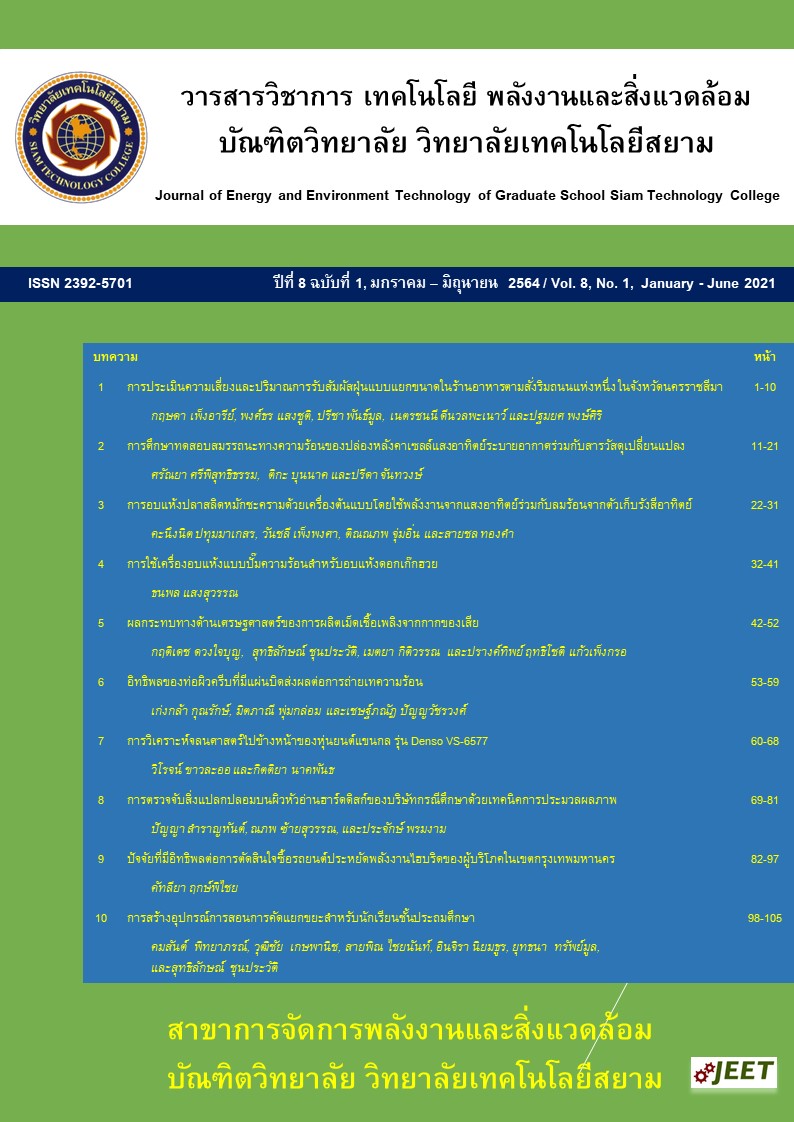การศึกษาทดสอบสมรรถนะทางความร้อนของปล่องหลังคาเซลล์แสงอาทิตย์ระบายอากาศร่วมกับสารวัสดุเปลี่ยนแปลง
Main Article Content
บทคัดย่อ
บทความนี้มีวัตถุประสงค์ทำการทดสอบเปรียบเทียบสมรรถนะทางความร้อนและการลดภาระความร้อนระหว่างบ้านจำลองที่ติดตั้งปล่องหลังคาเซลล์แสงอาทิตย์ระบายอากาศร่วมกับสารวัสดุเปลี่ยนแปลงติดตั้งพัดลมไฟฟ้ากระแสตรงกับหลังคาคอนกรีตทั่วไป โดยติดตั้งอยู่บนหลังคาหันไปทางด้านทิศใต้ของบ้านจำลองขนาดเล็กทั้ง 2 หลัง ที่มีปริมาตรเท่ากับ 1.73 ตารางเมตร เพื่อเปรียบเทียบสมรรถนะของบ้านจำลองที่ติดตั้งปล่อหลังคา PVRSC-PCM จะมีอุณหภูมิอากาศภายในต่ำกว่าห้องของบ้ายจำลองที่ติดตั้งหลังคาคอนกรีตทั่วไปและสามารถเพิ่มการระบายอากาศภายในห้อง. ทำให้มีอากาศไหลเวียนและลดค่าความร้อนจากห้องใต้หลังคาได้ดีกว่าห้องของบ้านที่ติดตั้งหลังคาคอนกรีตทั่วไป ดังนั้นปล่องหลังคา PVRSC-PCM จึงเป็นการเปลี่ยนแปลงส่งเสริมพัฒนาการใช้พลังงานแสงอาทิตย์ในการอนุรักษ์พลังงานและรักษาสิ่งแวดล้อม
Article Details

This work is licensed under a Creative Commons Attribution-NonCommercial-NoDerivatives 4.0 International License.
เนื้อหาและข่อมูลในบทความที่ลงตีพิมพ์ในวารสารวิชาการ เทคโนโลยี พลังงาน และสิ่งแวดล้อม บัณฑิตวิทยาลัย วิทยาลัยเทคโนโลยีสยาม ถือเป็นข้อคิดเห็นและความรับผิดชอบของผู้เขียนบทความโดยตรง ซึ่งกองบรรณาธิการวารสารไม่จำเป็นต้องเห็นด้วย หรือว่าร่วมรับผิดชอบใด ๆ
บทความ ข้อมูล เนื้อหา รูปภาพ ฯลฯ ที่ได้รับการตีพิมพ์ในวารสารวิชาการ เทคโนโลยี พลังงาน และสิ่งแวดล้อม บัณฑิตวิทยาลัย วิทยาลัยเทคโนโลยีสยาม ถือเป็นลิขสิทธิ์ของวารสารวิชาการ เทคโนโลยี พลังงาน และสิ่งแวดล้อม บัณฑิตวิทยาลัย วิทยาลัยเทคโนโลยีสยาม หากบุคคล หรือหน่วยงานใดต้องการนำทั้งหมด หรือส่วนหนึ่งส่วนใดไปเผยแพร่ต่อ หรือเพื่อกระทำการใด ๆ จะต้องได้รับอนุญาต เป็นลายลักษณ์อักษรจากวารสารวิชาการ เทคโนโลยี พลังงาน และสิ่งแวดล้อม บัณฑิตวิทยาลัย วิทยาลัยเทคโนโลยีสยาม เท่านั้น
References
Chantawong P. Israngkura N A B. Ungkoon Y. Natural ventilation of houses by a Roof Autoclaved Aerated Concrete Solar Chimney Under Hot Humid Climate of Bangkok. KKU Sci J 2012: 40:1:83-94. (In Thai).
Michels C. Lamberts R. Güths S. 2007. Evaluation of heat flux reduction provided by the use of radiant barriers in clay tile roofs. J Energy and Buildings 2008:40:4:445–451.
Khedari J. Sangprajak A. Hirunlabh J. Thailand climatic zones. J Renewable Energy 2002;25:2:267–280.
Chirarattananon S. Chaiwiwatworakul P. Pattanasethanon S. Daylight availability and models for global and diffuse horizontal illuminance and irradiance for Bangkok. J Renewable Energy 2002;26:1:69-89.
Levinson R. Akbari H. Reilly J C. Cool tile-roofed buildings with near-infrared-reflective non-white coatings. J Building and Environment 2007;42:7:2591-2605.
Ogoli D M. Predicting indoor temperatures in closed building with high thermal mass. J Energy and Buildings 2003;35:7:851–862.
Hendron R. Farrar-Nagy S. Reeves P. Hancock E. Thermal performance of unvented attic in hot-dry climates: Results from building America.J Transactions of the ASME 2004;126:732-737.
Khedari J. Hirunlabh J. Bunnag T. Experimental study of a roof solar collector towards the natural ventilation of new houses. J Energy and Buildings 1997; 26: 159-164.
Khedari J. Mansirisub W. Chaima S. Pratinthong N. Hirunlabh J. Field measurements of performance of roof solar collector, J Energy and Buildings 2000;31:171-178.
Chantawong P. Khedari J. Hirunlabh J. Study of cooling load reduction by solar cells attic ventilation of house model under climate of Bangkok. Ladkrabang Engineering Journal 2012;29:2:66-71, (In Thai).
Chantawong P. Vimanjan V. Natural ventilation of houses model by a roof solar cells turbine ventilator assisted with DC fan under climate of Bangkok. J KMUITNB 2012;22:2:305-314, (In Thai).
Chantawong P. Experimental Comparative Study between a Simple Roof Concrete and Roof Solar Cells Chimney Assisted with DC Fan and Life Cycle Cost Analysis. J KMUTNB 2013;23:1: 104-114, (In Thai).
Chantawong P. Investigation of Thermal Performance of Roof Solar Cells Chimney assisted with DC fan Under the Climate of Bangkok. Ladkrabang Engineering Journal 2011:28:1:19-24, (In Thai).
Ok Lee K. A, Medina M, Raith E, Sun X: (2015) “Assessing the integration of a thin phase change material (PCM) layer in a residential building wall for heat transfer reduction and management”, Applied Energy. 137, pp699-706.

